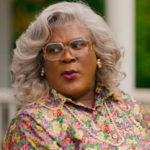“A Tree. A Rock. A Cloud.” Comes to Life
July 17, 2017, 01:41 PM
https://www.aotg.com/a-tree-a-rock-a-cloud-comes-to-life/
Known for her roles in front of the camera in “Raiders of the Lost Ark,†“Animal House,†“Scrooged†and more, Karen Allen recently took on a new role: the director of “A Tree. A Rock. A Cloud.†Adapted from the Carson McCullers tale, the new short film focuses on the story of a young boy and an old man that meet by chance at a roadside café and discuss lost love. Directed by Allen, the film stars Jeffrey DeMunn (“The Shawshank Redemption,†“The Green Mile,†“The Walking Deadâ€), James McMenamin (“Orange Is the New Blackâ€) and newcomer Jackson Smith, a young local actor from the Berkshires, Mass. where the film was shot. “This was such a passion project for me because it’s a story I’ve long admired by an author, Carson McCullers, that I am a huge fan of. I read the story when I was in my early twenties and it stayed with me over the years. For me it had to do with the characters she created and this beautiful story that unfolds about the nature of love,†explains Allen. “When I thought about directing my first film, this story came to mind as a perfect project. It has only a few locations and only three speaking roles for actors, so it has a beautiful simplicity for a first time director,†continues Allen. Going Into The Past “The main challenge in pre-production was that it’s a period piece: it’s set in 1947. The choice to shoot in black and white evolved over a period of time. I had watched the wonderful Polish film ‘Ida’ that won the Academy Award for Best Foreign Film in 2015 and was very moved by it. I loved the way it looked in black and white, as well as the style in which it was shot. In conversations with my cinematographer Richard Sands, we began to feel that black and white would set the film into the time period beautifully and also allow the storytelling to focus more on the characters,†describes Allen. With a career spanning more than 35 years, Richards Sands has worked behind the camera and as a Chief Lighting Technician on films such as “Bram Stoker’s Dracula,†“A.I. Artificial Intelligence†and “Independence Day.†“Since I have a dual background in lighting as well as cinematography, it’s all about light when I shoot. This is especially true when working with black and white – you need to plan out your shots so you get the exact light, contrast and composition you want,†explains Sands. “We chose a real restaurant in the Berkshires as the set for the café, which we felt added a sense of authenticity and intimacy. Academy Award-nominated Production Designer Kristi Zea transformed it into the perfect 1947 café. Karen and I started by walking the set to understand the nature of it. We identified a few challenges early on that became easy to deal with later because of planning and selecting the right gear for the job,†continues Sands. “For example, for a bulk of the film there’s a 50/50 profile shot where the old man and the young boy are talking in a booth. We had the perfect booth but it was right in front of a window that had light shining in, as well as a light above. There was a risk of the window being blown out but since I knew the exposure dynamics ahead of time, I was able to use the right camera and settings to get the contrast I wanted without having to worry about clipping the blacks or whites.†“It was important to test out things in the black and white environment. For example, we had to do wardrobe testing to make sure the greys were what we wanted. By doing this planning ahead of time, we were able to capture the exact look we wanted,†said Sands. Black and White with Blackmagic Design “Selecting our gear was pretty straightforward – Richard had just recently purchased a Blackmagic URSA Mini 4.6K and had talked about it enthusiastically. As soon as we began to shoot wardrobe tests, I loved the way the film looked,†said Allen. “The camera’s dynamic range was key,†adds Sands. “Since we were shooting in black and white, it was crucial to not have any noise in the blacks. The URSA Mini 4.6K’s dynamic range got us exactly what we wanted and we didn’t have to worry about there being any clipping in the blacks or whites.†Colorist Rob Bessette from Boston-based Finish Post then used Blackmagic Design’s DaVinci Resolve Studio to color grade the film. “Overall, we wanted the film to have nice contrast with deep blacks. I started by doing a first pass to find the general balance, making sure the contrast and saturation were where I wanted them. Then I dove into the black and white. “While black and white can be achieved by turning the saturation all the way down, that really limits you. In my experience, a better way to approach it is by leveraging DaVinci Resolve Studio’s monochrome mode. It allows you to turn the image to black and white while still giving you control of the RGB mixer. This way you can still isolate colors and finesse them as you go – for example, popping skintones by adjusting the red channel. If you just turn down the saturation, you lose a lot of flexibility which inhibits your creative freedom and the ability to isolate colors.†“The film primarily takes place in two locations at the café: at the counter and the booth by the window,†continues Bessette. “For the counter shots, I just had to adjust the overhead lights a bit. The booth shots were a bit trickier since a majority of the film was shot there and there were different levels of light shining in due to weather and cloud cover changing outside while we were filming. I used DaVinci Resolve Studio’s tracking tools to create custom mattes that keep everything consistent, especially with how the light was shining on the actors’ faces.†“I worked on DaVinci Resolve in the editing process and found it very easy to work with as a first time director,†concludes Allen. About “A Tree. A Rock. A Cloud.†The directorial debut for Karen Allen, “A Tree. A Rock. A Cloud.†is a short film based on the story by Carson McCullers. Produced by Diane Pearlman and Brian Long, the film won “best International Narrative Short†at the Manchester Film Festival and has continued its run at the River Run Film Festival and USA Film Festival, where Jackson Smith won the “Best Newcomer†award. It will soon be screened as part of the Cannes Film Festival’s Short Film Corner and Berkshire International Film Festival. For more information, visit http://www.atreearockacloudthefilm.com.DP Richard Sands captured the short film with an URSA Mini 4.6K while Colorist Rob Bessette turned the world black and white with DaVinci Resolve Studio
#color grading#post production#color correction#monochrome
Newest from AOTG.com
-

Daniel George McDonald on Editing Cheer's Season 2 Finale
Daniel George McDonald sits down to discuss creating the finale for Cheer Season 2.
-

Editing The Black Lady Sketch Show
Gordon sits down with the editorial team of The Black Lady Sketch Show to discuss their approach to ...
-

Philip White on Crafting A Madea Homecoming's Music
Gordon sits down with Philip to discuss his work with Tyler Perry and his latest film A Madea Homeco...
Site Links
Tools
Sister Sites
© 2007-2024 www.aotg.com Ver. 3.0 All Content created and posted by Art of the Guillotine users Art of the Guillotine graphics, logos, designs, page headers, button icons, scripts, and other service names are the trademarks of Art of the Guillotine Inc. Use of this material outside of this site is strictly prohibited.